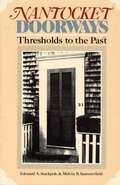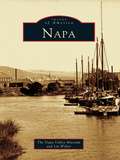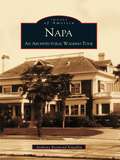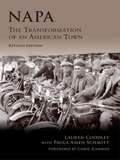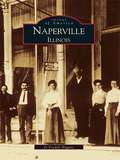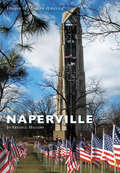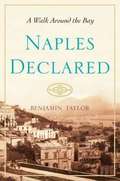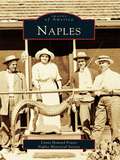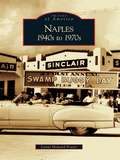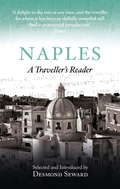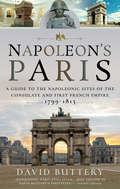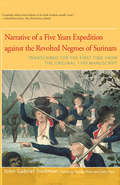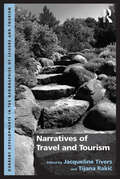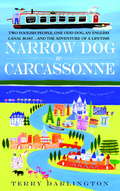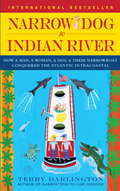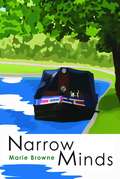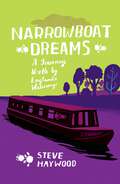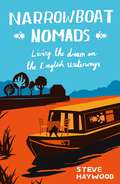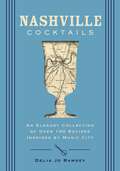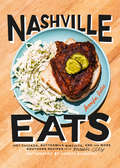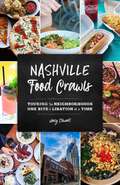- Table View
- List View
Nantucket Doorways
by Edward A. Stackpole Christoph B. SummerfieldOnce a major whaling center, Nantucket today draws thousands to its New England shores as one of America's leading summer resorts. The author gives guided tour of the homes of such noted families as the Macys, the Folgers and the Starbucks.
Napa
by The Napa Valley Museum Lin WeberThe name "Napa" may come from "Napato," a clan of the Wintun Indians who once lived along a river that flows into San Francisco Bay. In the 1850s, miners sought refuge in the young city that grew up by the Napa River, living in tents along its main street. Later they and other newcomers found work at businesses and nearby ranches while Napa City flourished as goods and produce from all over the valley were loaded onto steamers bound for San Francisco. Shortening its name in 1900, Napa continued to provide housing and shops, utilities and transportation for a growing agricultural center, and it shared the valley's economic hard times through Prohibition and the Great Depression.
Napa: An Architectural Walking Tour
by Anthony Raymond KilgallinThough world-famous for its miles of superior vineyards, Napa offers much more to the historian than its reputation as wine maker. Just an hour from San Francisco and Sacramento, the many towns of the Napa region are small enough to be walkable, friendly, and unique in design. The 240 images in this new book, with some photographs never before collected, demonstrate the architectural and historical diversity of this beautiful region, presented in walking-tour format. Through vintage photographs, the reader is pulled back in time to 1880 Napa, where a scant but diverse 4,000 residents reside. Of those people, only 163 were actually born in California, which accounts for the variety of architectural styles throughout the county. The multinational heritages of Irish, German, English, Canadian, Swiss, Scottish, French, Swedish, Mexican, Italian, and Chinese settlers are richly expressed through the architecture and landmarks of Napa's villages and towns. Captured here are the homes and structures that give the region its glow, including Napa's Churchill Manor, Greystone Winery in St. Helena, Magnolia Hotel in Yountville, and Stags Leap manor in the heart of the Stags Leap District.
Napa: The Transformation of an American Town
by Lauren Coodley Carol Kammen Paula Amen SchmittWith roots set deep in California history, Napa's story reaches back to the Bear Flag Rebellion and earlier, to the first contact between Spanish explorers and the Wappo Indians. Through the founding of Spanish missions and the grants of ranchos by the Mexican government, Napa flourished under the various cultures that helped it become one of the west coast's most dynamic cities. As it bloomed into one of the most recognizable names on the American landscape, Napa's residents confronted issues of war and peace, of open space and sprawl.
Naperville, Illinois
by Jo Fredell HigginsThe remarkable city of Naperville, Illinois, began as an agrarian community in the mid-1800s. The rich prairie filled the grain elevators and cattle were shipped to the Chicago "Yards." Through the medium of historic photographs, this book captures the evolution of the people of Naperville, from the mid-1800s to the present day. These pages bring to life the people, events, communities, and industries that helped to shape and transform Naperville. With more than 200 vintage images, Naperville, Illinois, portrays a community that is both idyllic and contemporary. This book takes readers back to Naperville's simpler days, and provides a glimpse as to how this community grew into a new mecca. Business and commerce thrive, the schools offer quality education, city services are national award-winning, cultural activities are diverse and plentiful, and traditions blend easily with the future.
Naperville: Illinois (Images of Modern America)
by Jo Fredell HigginsNaperville is a quintessential American city, where many cultures blend together in harmony. Founded in 1831 by Capt. Joseph Naper and incorporated in 1857, the city has progressed from rural farmland to a robust commercial economy. In 1860, kerosene lamps and one wooden bridge were surrounded by the sounds of prairie fowl and croaking frogs. In 1960, the population exploded. Now, 21 languages are spoken in the community, and the meandering downtown Naperville Riverwalk offers bucolic serenity to those strolling along the Century Walk artwork. Naperville has two partner Sister Cities that strengthen culture and business: Nitra, Slovakia (as of 1993), and Pátzcuaro, Mexico (as of 2010). The city comes alive thanks to its people and families, organizations, leaders, and events. It is filled with a rich culture that values the history of yesterday while looking forward to tomorrow’s joys. Naperville is simply outstanding in every manner and mode of living.
Naples Declared: A Walk Around the Bay
by Benjamin TaylorIt is a city of seemingly irreconcilable opposites, simultaneously glorious and ghastly. And it is Ben Taylor’s remarkable ability to meld these contradictions into a whole that makes this the exciting and original book it is. He takes his stroll around the bay with the acute sensitivity of a lover, the good humor of a friend, and the wisdom of a seeker who has immersed himself in all aspects of this contrapuntal culture. His curiosity leads him to many byways, both real and metaphoric, and his passion for this ancient city and its people becomes, in his graceful prose and amusing anecdotes, irresistibly contagious. .
Naples: 1940s To 1970s (Images of America)
by Lynne Howard Frazer Naples Historical SocietyNaples celebrates the story of one of southwest Florida's most renowned beach resorts, from its tenuous beginning in 1885 through the tumultuous year of 1960, when Hurricane Donna nearly destroyed the town once hailed as the "Summerland in Wintertime." Founded as a place where "invalids can escape the chilling blasts of winter," the distant paradise was accessible only by boat, and by 1890, the new town boasted a pier, the Naples Hotel-and little else. With train service arriving in Naples in 1927 and the opening of the Tamiami Trail in 1928, the once-remote resort was finally open to development, but the Depression turned the dreamed-of boom into a bust until after World War II. The picture-perfect beaches and warm winter climate were soon "rediscovered," and by the time Hurricane Donna stormed ashore on September 10, 1960, Naples was the fastest-growing city in Collier County.
Naples: 1940s to 1970s (Images of America)
by Lynne Howard FrazerNaples was not much more than a bend in the road in the 1940s, but by 1950, its beautiful beaches and balmy weather had been rediscovered, and development and tourism became the city's lifeblood. Although Hurricane Donna struck Naples in 1960, the building boom continued, and by the late 1970s, few undeveloped areas remained. The last large gulf-front parcel was acquired in 1972 for the development of a new luxury community called Pelican Bay. More than 200 images offer insight into this rarely chronicled period of Naples's history, including seldom-seen historic photographs from the archives of the Naples Daily News (formerly the Collier County News) and vintage postcards from the collection of Nina Heald Webber.
Naples: A Traveller's Reader
by Mr Desmond SewardMany Italian cities look back with pride to the days when they were independent republics: Naples, on the contrary, remembers its days as a royal capital, the brilliant administrative and political centre of The Kingdom of The Two Sicilies, ruled over successively by the house of Anjou, Aragon and Bourbon. Once 'the third city of Europe', today it is one of the least visited of the continent's great cities. The same bustling lively atmosphere and magnificent buildings that one finds in Paris or London exist here.This book is a topographical anthology which recreates for today's tourist the drama, the history and the life of a city in buildings and locations that still exist today. An indispensable companion, it brings the past of Naples vividly to life for the traveller of the present. Extracts from chronicles, memoirs, biographies, letters and novels refer to the most important and beautiful buildings in and around Naples, as well as the lives of travellers to and residents of this famous city.This is a guide to the vanished glories of royal Naples: the departure of the Borbone King Francis II in 1860 as the Risorgimento movement brought about unification of Italy. It records the turbulent and bloodstained days of the Angevin Queens Giovanna I and II, and the revolt led by the young fisherman Masaniello; the artistic life of the city that Petrarch knew, where Caravaggio, Ribera and Giordano painted, and which attracted such diverse visitors as Nelson and Lady Hamilton, Casanova, Goethe, Mozart, John Evelyn and Angelica Kauffman among countless others. The dazzling world of the royalty - their palaces overlooking the legendarily beautiful Bay of Naples, their court balls and ceremonies - is described as well as the pulsing, overcrowded slums of the Spanish quarter and the seafront with its tarantella-dancers, iced-melon vendors, pickpockets and throbbing Neopolitan songs.Naples is still, as it always has been, a city of challenging contrasts: sunlight and squalor, grandeur and decay, gaiety and despair. Its slums and its crime-rate have deterred many, but those who persist will discover, through this illuminating guide, the hidden glories of this famous city.
Napoleon's Paris: A Guide to the Napoleonic Sites of the Consulate and First French Empire 1799–1815
by David ButteryA specialist in Napoleonic history reveals the legendary leader’s influence on the City of Light in this illustrated visitor’s guide.Historian David Buttery explores the many connections between Napoleon and Paris, where many remarkable buildings and monuments date from his time in power. Many of the city’s most famous sites were built or enhanced on Napoleon’s instructions, while others are closely associated with him and the First French Empire.Buttery explores the Napoleonic history of the Arc de Triomphe, the Louvre, the Hôtel des Invalides, Musée de l’Armée, Notre Dame Cathedral, Père-Lachaise Cemetery, and other fascinating sites. Full of evocative detail and practical information, Napoleon’s Paris is essential reading for every history buff who visits the French capital.
Narrative of Five Years Expedition Against the Revolted Negroes of Surinam: Transcribed for the First Time From the Original 1790 Manuscript
by Richard Price John Gabriel Stedman Sally PriceWhen John Gabriel Stedman's Narrative of Five Years Expedition was first published in 1796--a bowdlerized edition "full of lies and nonsense"--Stedman claimed to have burned two thousand copies. It nevertheless became an immediate popular success. A first-hand account of an eighteenth-century slave society, including graphic accounts of the worlds of both masters and slaves, it also contained vivid descriptions of exotic plants and animals, of military campaigns, and of romantic adventures. Illustrated by William Blake, Francesco Bartolozzi, and others, Stedman's work was quickly translated into a half-dozen languages and was eventually published in over twenty-five different editions. The Prices' acclaimed critical edition is based on Stedman's original, handwritten manuscript, which offers a portrait at considerable variance with the 1796 classic. The unexpurgated text, presented here with extensive notes and commentary, constitutes one of the richest and most evocative accounts ever written of a flourishing slave society. The Prices restore early omissions involving Stedman's horror at the Dutch planters' use of casual torture to discipline their slaves; his love and admiration for Joanna, his mulatto mistress; his strong belief in racial equality; and his outrage that "in 20 Years two millions of People are murdered to Provide us with Coffee & Sugar." Freed from its original publisher's censorship, Stedman's Narrative stands as one of the strongest indictments ever to appear against New World slavery.
Narratives of Travel and Tourism (Current Developments In The Geographies Of Leisure And Tourism Ser.)
by Tijana RakicTravel and tourism 'stories' have been told and recorded within every culture, in every period of oral and written history, and across the breadth of the fact/fiction continuum. Taking two broad themes as its starting point - travellers and their narratives, and place narratives in travel and tourism - the book has a deliberately wide scope, with different chapters addressing the subject through various relevant 'lenses' and in relation to a number of different contexts. The narratives discussed include both historical and contemporary, as well as 'real-life' and fictional, narratives contained within travel writing, travel and tourism stories and different types of media. In relation to the principal themes of the book, some chapters also explore the importance of collecting memorabilia and image making in the recording, remembering, writing, telling or disseminating of stories about travel and tourism experiences and some examine the ways in which travel and tourism narratives may construct and reinforce personal, collective and place identities. The whole book is marked by an over-arching concern for narrative interpretation as a means of understanding, and providing a new perspective on, travel and tourism.
Narrow Dog to Carcassonne
by Terry Darlington"We could bore ourselves to death, drink ourselves to death, or have a bit of an adventure. . . "It was absurd. It was foolhardy. And it was glorious. When they retired, Terry Darlington and his somewhat saner wife Monica--together with their dog, a whippet named Jim--chucked their earthbound life and set out in an utterly unseaworthy sixty-foot canal narrowboat across the notoriously treacherous English Channel and down to the South of France. Aboard thePhyllis May,you'll dive through six-foot waves in the Channel and be swept down the terrible Rhône. You'll meet the French nobody meets--poets, captains, scholars, madmen; they all want to know the couple on the painted boat and their narrow dog. You'll visit the France nobody knows--the backwaters of Flanders, the canals beneath Paris, and the forbidden routes to the wine-dark Mediterranean Sea. Aliens, trolls, gongoozlers, killer fish, and the walking dead all stand between our two-person, one-whippet crew and their goal: the ancient, many-towered city of Carcassonne. A tale of travel, travail, dubious wine, a balky pump, and a boat built for only a few feet of water, this exuberantly inventive and hugely entertaining odyssey of the spirit, senses, and heart will enchant lovers of France, England, and all that lies between.
Narrow Dog to Indian River
by Terry DarlingtonFrom Virginia to Florida in an English canal boat. Join the authors of "one of the most hilarious travel memoirs ever written"* on a wild odyssey aboard one of the most unlikely craft ever to sail U. S. waters. No one had ever sailed an English narrowboat in the U. S. before--for reasons that become clear when Terry Darlington, his wife, Monica, and their well-traveled dog, a whippet named Jim, begin a nine-month voyage down the 1,150-mile Intracoastal Waterway. But no sooner do they set out in the seven-foot-widePhyllis Maythan they encounter an ice storm in Virginia and piranhas in North Carolina. The Georgia coast is a madman's jigsaw and in Florida the alligators wait patiently for Jim. But as they wend their way through golden marshes, incomparable cities, and lost arcadias, the intrepid trio aboard the beautiful painted boat reveals a South few of us have ever seen. And with frequent stops to dine on sweet tea, grits, and the freshest of the day's catch, they make plenty of strange companions along the way--from wayfarers stopping to give Jim a good scratch behind the ears to ex-CIA agents and the Good Ole Boys of the Deep South--and discover that everyone has a story they're only too willing to share. Beautifully written, lovingly observed and very funny,Narrow Dog to Indian Rivertakes you on a dangerous, surprising, and always entertaining journey through the wonderland of the South. *Booklist
Narrow Dog to Indian River
by Terry DarlingtonFollowing the triumph of thier trip through France to Carcassonne, these two pensioners (and thier whippet, Jim) now cast off in thier narrowboat down the Intracoastal Waterway of the USA - from VIrginia to the Gulf of Mexico.From the Hardcover edition.
Narrow Dog to Indian River
by Terry DarlingtonFollowing the triumph of thier trip through France to Carcassonne, these two pensioners (and thier whippet, Jim) now cast off in thier narrowboat down the Intracoastal Waterway of the USA - from VIrginia to the Gulf of Mexico.From the Hardcover edition.
Narrow Minds
by Marie BrowneIn her debut memoir Narrow Margins Marie Browne saved her family from financial ruin by moving her long-suffering husband three children and a dog on to a houseboat called Happy Go Lucky in search of a less stressful, alternative way of life. Now in Narrow Minds the family find themselves sucked back into normality, they're pretty much back where they started, horrible house, no boat and the kids are beginning to threaten mutiny. Facing perky postmen, ice skating cows, psychotic villagers and outraged rodents, they're running out of time, their financial situation is getting desperate and there's every chance life has conspired against them to make sure they never get back afloat. Until they find the answer to their dreams lies with Minerva, a narrow boat even more run-down than the first. This hilarious follow-up shows the lengths to which a desperate woman will go just to restore her preferred lifestyle.
Narrowboat Dreams: A Journey North by England’s Waterways
by Steve HaywoodSteve Haywood escaped the routine of his life in London for a voyage of discovery along England’s inland waterways, travelling by traditional narrowboat. With irrepressible humour he describes the history of the canals, the characters he meets along the way, and the magic that makes England’s waterways so appealing.
Narrowboat Dreams: A Journey North by England’s Waterways
by Steve HaywoodSteve Haywood escaped the routine of his life in London for a voyage of discovery along England’s inland waterways, travelling by traditional narrowboat. With irrepressible humour he describes the history of the canals, the characters he meets along the way, and the magic that makes England’s waterways so appealing.
Narrowboat Nomads: Living the Dream on the English Waterways
by Steve HaywoodWe were aware of a dreamlike quality to our trip. There was something far-fetched about it, something out of this world.Austerity might be getting everyone else down, but Steve is waving his worries goodbye on another of his light-hearted trips around the picturesque English waterways.This time it’s a bit different, though. This time he’s not just cruising with his cat, Kit, but with his long-suffering wife, Em, who’s given up work and wants her share of easy living too. They’ve rented out their home for the ups and downs of a life afloat, and there’s no goingback now as they cruise from the historic River Thames, through the Midlands and westward into the hills of Wales, meeting a familiar cast of eccentrics and oddballs along the way, and experiencing one of the hottest summers of recent years.But how, after life in a four-bedroom house, do they manage to survive together squeezed into a space the size of a potting shed? Other books pretend to tell you about life afloat – this one shows you what it’s really like.
Narrowboat Nomads: Living the Dream on the English Waterways
by Steve HaywoodWe were aware of a dreamlike quality to our trip. There was something far-fetched about it, something out of this world.Austerity might be getting everyone else down, but Steve is waving his worries goodbye on another of his light-hearted trips around the picturesque English waterways.This time it’s a bit different, though. This time he’s not just cruising with his cat, Kit, but with his long-suffering wife, Em, who’s given up work and wants her share of easy living too. They’ve rented out their home for the ups and downs of a life afloat, and there’s no goingback now as they cruise from the historic River Thames, through the Midlands and westward into the hills of Wales, meeting a familiar cast of eccentrics and oddballs along the way, and experiencing one of the hottest summers of recent years.But how, after life in a four-bedroom house, do they manage to survive together squeezed into a space the size of a potting shed? Other books pretend to tell you about life afloat – this one shows you what it’s really like.
Nashville Cocktails: An Elegant Collection of Over 100 Recipes Inspired by Music City (City Cocktails)
by Delia Jo RamseyNashville Cocktails is an elegant collection of over 100 recipes inspired by Music City.These signature drink recipes from Nashville hotspots pay homage to this lively city. With over 100 recipes and dozens of bartender profiles, you can drink like a local whether you're just visiting or entertaining at home. From honky-tonks to cozy speakeasies,locals and tourists alike will discover new watering holes that are sure to satisfy all tastes. With the best signature creations by prominent mixologists in the area, this book offers a detailed rundown of the best locations Nashville has to offer. Within the gorgeous, die-cut covers, you'll find:More than 100 essential and exciting cocktail recipes, including recipes for bespoke ingredients and other serving suggestionsInterviews with the city&’s trendsetting bartenders and mixologistsBartending tips and techniques from the expertsFood and drink hotspots across the cityAnd much more!Enjoy Nashville's craft cocktail scene without ever leaving your zip code with Nashville Cocktails.
Nashville Eats: Hot Chicken, Buttermilk Biscuits, and 100 More Southern Recipes from Music City
by Jennifer Justus&“Perfectly captures the spirit of Music City . . . An incredible collection of recipes that makes you want to spend as much time as possible in Nashville&” (Sean Brock, chef and author of Heritage). If it seems like Nashville is everywhere these days—that&’s because it is. GQ recently declared it &“Nowville,&” and it has become the music hotspot for both country and rock. But as hot as the music scene is, the food scene is even hotter. In Nashville Eats, more than one hundred mouthwatering recipes reveal why food lovers are headed south for Nashville&’s hot chicken, buttermilk biscuits, pulled pork sandwiches, cornmeal-crusted catfish, chowchow, fried green tomatoes, and chess pie. Author Jennifer Justus whips up the classics—such as pimento cheese and fried chicken—but also includes dishes with a twist on traditional Southern fare—such as Curried Black Chickpeas or Catfish Tacos. And alongside the recipes, Jennifer shares her stories of Nashville—the people, music, history, and food that make it so special. &“A love letter to the working-class cooking of Nashville . . . Nashville Eats by Jennifer Justus is a well-honed cultural passkey to one of America&’s great culinary cities.&” —John T. Edge, coeditor, The Southern Foodways Alliance Community Cookbook
Nashville Food Crawls: Touring the Neighborhoods One Bite and Libation at a Time (Food Crawls)
by Holly StewartNashville Food Crawls takes the reader on a fun, tasty culinary tour. Discover the hidden gems and long-standing institutions of Nashville neighborhoods. Experience more than 13 crawls, each featuring 3-8 establishments centered on a neighborhood or theme. Each tour is the complete recipe for a great night out, the perfect tourist day, a new way to experience your own city, or simply food porn and great stories to enjoy from home.
